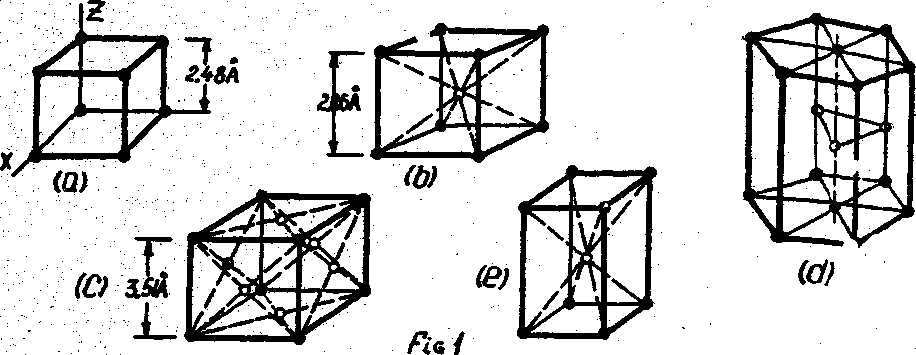
Lattice Structures.
Atoms are the building blocks1 of all materials. They are known to be put together in a great variety of ways and bonded by cohesive forces in a manner characteristic of a particular
material2.
In the liquid state the atoms of a metal are said to be in somewhat random arrangement, having short-range order3. At times several unlike atoms happen to arrange themselves in the characteristic pattern of a particular metal. However, this is a probability event4. Since the forces are weak tad there is much activity taking place, they soon separate and re-form again. This phenomenon of random grouping, scattering, and regrouping for short periods of time is characteristic of the liquid state. As the mechanism becomes less frequent and the atomic movement of unlike atoms becomes more agitated, the material may become a gas.
As the energy input decreases, the random movement of the unlike atoms becomes less frequent, the bonding becomes stronger, and ordered arrays of atoms5 form lattices. These lattices form crystals, and many crystals form a pattern which we call the solid material.
The imaginary lines that connect the centers of the atoms are called lattice structures. The most common metals are almost sure to crystallize in one of three types of lattice systems: cubic, hexagonal, and tetragonal.

Figure la shove eight atoms forming a simple cubic lattice structure. The sides, of the lattice are equal in length and form a cube. This cube may have another atom at its center (Fig.1b), in which case6 it is called я body-centered cubic lattice (BCC). The cube may also have an atom in each of its faces as shown in Fig.1c. This lattice is called a face-centered cubic lattice (FCC).
Body-centered cubic lattice structures are found in the following metals: barium, cesium, potassium, lithium, molybdenum, sodium, rubidium, tantalum, vanadium, chromium, iron (alpha and delta), and tungsten.
Face-centered cubic lattice structures are found in the following metals: aluminum, copper, gold, iron (gamma), lead, nickel, platinum, silver.
The close-packed hexagonal (CPH) lattice structure is shown in Fig.1d.
Materials that have a CPH structure are beryllium, cadmium, cobalt, magnesium, osmium, tellurium, titanium, zinc, and zirconium.
Fig.1e. shows a body-centered tetragonal (BCT) lattice. It is an elongated body-centered cubic lattice structure. Tin and manganese at elevated temperatures exhibit this lattice structure.
It is important to note that several of the metals in common use7 exhibit lattice structure changes as their temperatures increase, e.g.
cobalt: |
close-packed hexagonal, below 420°C face-centered cubic, 420 to I495°C |
iron: |
body-centered ( ) cubic, below 9I0°0 face-centered ( ) cubic,910 to I400°C body-centered( )cubic, 1400 to I535°0 |
tin: |
cubic ( )» below I3°C tetragonal ( ), I3°C to 232CG |
titanium: |
close-puked hexagonal, below 880°в body-centered cubic, 880 to I/2i?°G |
